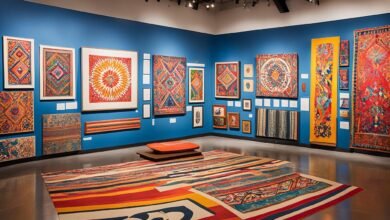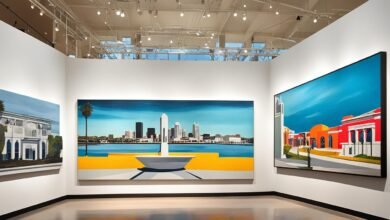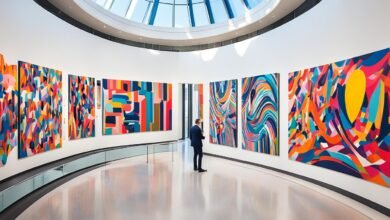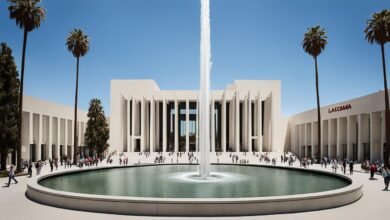Table of Contents
The Museum of Tolerance in Los Angeles is more than a museum. It’s a place that changes how we see the world. For years, it has taught people the importance of human rights and understanding our past. This museum is a key part of efforts to bring about real change. It focuses on things like the Holocaust and civil rights, showing why we should care about them. When you visit, you’ll come away with new knowledge and a desire to support fairness for all.
The Museum of Tolerance’s Educational Mission
The Museum of Tolerance is all about changing how students see the world. It uses cool tech, moving exhibits, and old stories to make learning powerful.
The museum mainly targets students for a reason. It wants them to grow into caring adults who value everyone. The museum does this by showcasing important lessons in a fun way. This helps kids grow in many ways.
“Our mission is to light a fire in students, pushing them to make their world kind and fair. This begins in their schools, reaching out to everyone.”
It’s not all boring history lessons either. The museum lets kids dive deep into what they believe, teaching them about respect and fairness. They get to really think about big ideas for themselves.
The museum also works hand-in-hand with schools. It brings its powerful lessons right into classrooms. This way, kids learn to think for themselves about big moments in history and what they mean now. This grows their minds and their desire to make the world better.
The goal is more than just learning facts. The museum dreams of kids standing up for fairness in the world. It offers a place where talking about important stuff is not just allowed but encouraged. Here, kids learn they can truly make a difference.
Teaching Technologies and Interactive Exhibits
At the Museum of Tolerance, learning is fun and techy. Students get to touch and feel history through cool exhibits. This helps them get closer to the story.
By using movies, VR, and great storytelling, the museum brings history to life. This makes learning exciting. The interactive bits help students dig deep and think smart.
Being high-tech isn’t just about now. It’s about getting ready for the future. The museum teaches in ways that fit the modern world. It gives students skills they need to succeed later on.
Archives and Learning Resources
The museum is packed with real history waiting to be explored. Old stuff, new tech, and stories tell important past events. This helps students see the world more kindly.
With all these tools, students can understand history better. They learn to see different sides of stories. This makes learning richer, going beyond what’s in books.
The Museum’s Impact on Students
Students leave the museum forever changed. They don’t just know more history; they understand why respect and fairness are so important. They learn about treating everyone well.
What they take from the museum can make them leaders. They learn to help others with love and wisdom. This way, the next generation will be kinder and better at fixing the big problems we face.
Museum of Tolerance Tour: A Journey of Discovery
Join a thrilling journey at the Museum of Tolerance. Dive into exhibits that make you think about tolerance and its impact. Learn about tolerance and its opposite, intolerance, through engaging exhibits. Each exhibit is meant to make us think and better understand life.
Interactive Exhibits
Enter the Point of View Diner and see issues from different angles. You’ll learn how choices affect people and the world. This exhibit pushes you to think deeply and consider moral questions carefully.
The Millennium Machine is a place for global solutions. Join others in finding ways to solve human rights issues. Talk with others, study real cases, and leave inspired to change the world for the better.
American History Wall
Explore the American History Wall’s lessons on tolerance and equality. See key moments in the fight for civil rights. Learn from the past to help shape a better future.
In Our Time: Confronting Hate in America
See how hate affects our world in the In Our Time exhibit. Through stories and videos, learn about hate movements. Understand the harm of prejudice and why fighting against hate is crucial today.
New Face of Hate: Globalhate.com
Visit the New Face of Hate exhibit to see online hate’s impact. Learn how hate groups use globalhate.com to spread messages. Discover how we can use tech to stop hate and promote unity.
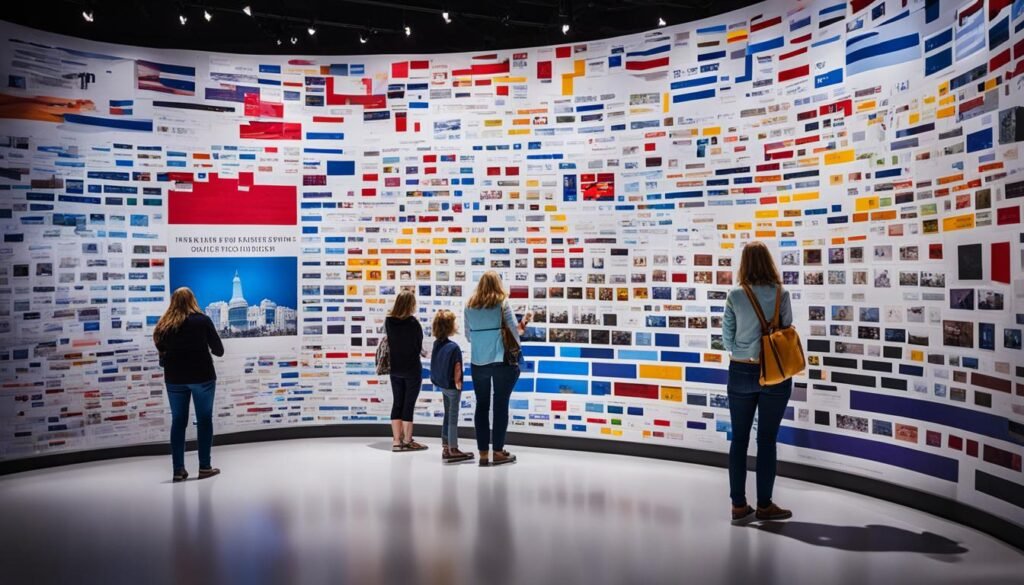
The Museum of Tolerance invites you to a journey that changes you. It challenges your views, sparks conversations, and urges for a more tolerant world. Experience the exhibits, discuss with others, and leave ready to stand against hate.
Holocaust Exhibit: Connecting with the Past
The Museum of Tolerance features a powerful Holocaust exhibit. It helps visitors feel a personal connection with the past. They can see artifacts like Anne Frank’s letters, a bunk bed from Majdanek, and an American flag made at Mauthausen.
This exhibit does more than show artifacts. It immerses visitors in an educational experience about World War II and the Holocaust. With multimedia and interactive features, it makes this history vivid and impactful. It teaches about discrimination and intolerance.
The exhibit includes a Multimedia Learning Center. Here, visitors can use computers and watch videos to learn more. They get access to a wide range of historical information, helping them fully grasp this dark period.
Walking through, visitors hear stories of survival and hope. They see tangible evidence of the Holocaust’s horrors, which brings empathy. This deepens their connection with those who lived through these terrible events.
The exhibit aims to teach about the Holocaust’s past while inspiring action against discrimination today. It encourages critical thinking, empathy, and a drive for social justice. Its goal is to make a lasting impact on its visitors.
Key Artifacts in the Holocaust Exhibit
| Artifact | Description |
|---|---|
| Correspondence | Letters exchanged between Anne Frank and her pen pals, providing a personal insight into her life during the Holocaust. |
| Bunk Bed | A bunk bed salvaged from the Majdanek death camp, symbolizing the harsh living conditions endured by prisoners. |
| American Flag | An American flag sewn by inmates of the Mauthausen concentration camp, representing the resilience and defiance of those held captive. |
The Museum of Tolerance’s Holocaust exhibit offers a deeply engaging and profound way to learn history. Through its artifacts and resources, visitors can truly connect with the Holocaust’s impact on our society.
Innovative Methodologies for Professional Development
At the Museum of Tolerance, we see the value in always growing professionally. We provide new approaches that transform learning. This helps in both career advancement and creating positive changes.
Our way of teaching is hands-on and centers around you, the learner. You will be active in discussions and activities about challenging topics. This will lead to a new understanding of personal responsibility and how you can make a difference.
Skilled guides will lead you through activities that make you think deeply. They will also help you see your impact on issues like social justice and democracy. These talks will make you aware of the big roles words and images play in our world.
We offer programs in many forms to suit various needs and schedules, including workshops and leadership retreats. No matter what role you have, we have a fitting program for you. This will boost your skills and knowledge.
Our interactive exhibits are a special part of your experience. They help you and your group learn in a powerful way. This makes our programs even more effective, giving you important insights and new connections.
Benefits of our Innovative Methodologies:
- Hands-on and experiential learning opportunities
- Facilitated discussions that challenge assumptions
- Safe environment for probing dialogue around difficult issues
- Enhanced understanding of personal responsibility and social justice
- Promotion of diversity, democracy, and inclusivity
- Tailored programs to meet your specific needs
- Immersive learning environment for deep insights
“The power of professional development lies in its ability to transform individuals and organizations. By embracing innovative methodologies, we have the opportunity to create a more inclusive and just society.” – Museum of Tolerance
Come to the Museum of Tolerance and see how our innovative methods can transform your career. Let’s work together to make a difference in our lives and communities.
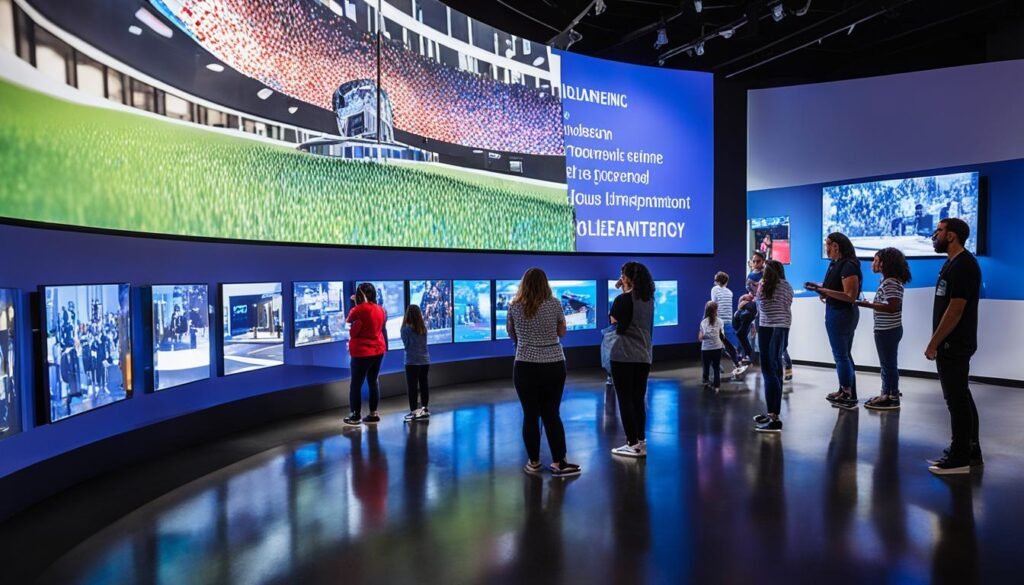
| Professional Development | Experiential Learning | Facilitated Discussions | Immersive Learning Environment | Power of Words and Images | Pursuit of Social Justice | Diversity and Democracy | Curricular Materials |
|---|---|---|---|---|---|---|---|
| Transformative programs that empower individuals | Hands-on learning experiences that foster growth | Engaging dialogues that challenge assumptions | An environment that immerses you in learning | Exploration of the impact of words and images | Advocacy for a more just and equitable society | Celebration and promotion of diversity and inclusivity | Resources and materials to support your learning |
Powerful Learning Environments at the Museum
The Museum of Tolerance lets people learn in special ways. It uses activities that involve touching and feeling. This is much more than listening to someone talk.
Through fun and engaging exhibits, the museum focuses on important topics. These include the effects of words and images. It also touches on making society fair and how different people fit together in a democracy.
Everyone gets time to really dive into the exhibits. This makes learning more personal and sticks with you. It helps both individuals and groups think more deeply about what they see.
This method makes learning memorable and powerful. It’s not just about facts but about understanding big ideas.
| Benefits of Interactive Exhibits at the Museum |
|---|
| – Engages participants in a hands-on and immersive learning experience |
| – Explores themes like the power of words and images, social justice, and diversity and democracy |
| – Provides dedicated time for individual and group insights |
| – Enhances the overall learning experience |
Reminders for Your Museum Visit
Planning your visit to the Museum of Tolerance is key to a great experience. Here are some key tips to help you enjoy your time there:
- Scheduled Tour: Be on time for your tour. Latecomers may miss parts of the tour. So, plan your trip wisely and allow for possible delays.
- Security Procedures: Extra time is needed for security checks at the entrance. Your patience and help are valued for everyone’s safety.
- Chaperones: With a school group, bring two chaperones for every 25 students. They help keep everyone safe and following the rules.
- Tour Guidelines: Respect and education are top priorities. Please follow the museum’s tour rules. They’re there to make your visit better and more insightful.
- Visitor Expectations: Keep an open mind at the Museum of Tolerance. It’s a chance to think deeply about history and its connection to our lives today.
- Age Recommendation: Some exhibits may not be for young children. Kids under 12 should come with an adult who can help them understand what they’re seeing.
- Visitor Etiquette: Wearing your name tag and not bringing in certain items is good etiquette. It helps make the space respectful for all.
- Photography and Videotaping: Please don’t take pictures or videos. This rule is to respect the privacy and rights of everyone.
- Comfort and Safety: Dress comfortably and have a jacket ready if it might get cold. Always have emergency contacts for any children with you.
By keeping these points in mind, your time at the Museum of Tolerance will be rewarding. Come ready to learn and explore the importance of tolerance and human rights.
Facilitating Dialogue and Reflection
The Museum of Tolerance values dialogue and reflection to enhance learning. It has skilled guides to make a safe space. Here, everyone can freely talk about their ideas and emotions. Rules help keep the talk open and respectful, giving all a chance to speak. The “talking stick” method makes sure everyone listens and speaks up.
Students are asked to use “I” statements in conversations. This helps them talk about what they’ve personally gone through. They’re also asked open questions that make them think. Questions like, “What happened?”, “Why?” and “What do you think about it?” push them to understand complex issues around tolerance and social fairness.
Facilitators create a safe space where students can express their ideas, thoughts, and emotions.
After conversations, there’s time for private or group reflection. Keeping a journal helps students sort their thoughts and feelings. Sharing these in groups allows deeper discussions. These times of reflection help students understand themselves and others better. This builds empathy and reminds them of the need for social responsibility.
| Key Points | Benefits |
|---|---|
| Facilitated dialogue | Encourages open and respectful communication |
| Expressing ideas and emotions | Fosters personal growth and self-reflection |
| Ground rules | Establishes a safe environment for sharing |
| Talking stick technique | Ensures equal participation and active listening |
| Opinion sharing | Promotes diverse perspectives and critical thinking |
| Open-ended questions | Encourages deeper exploration and reflection |
| Reflection opportunities | Allows for personal and group growth |
Encouraging dialogue and reflection at the Museum of Tolerance sparks change. It helps students work towards a more open and tolerant society.
Teaching the Holocaust and Tolerance Concepts
Teaching about the Holocaust and tolerance is hard because these topics are deep and sometimes tough to talk about. The Museum of Tolerance offers great advice to help teachers approach these topics in a caring, respectful way.
It is vital not to simplify or make general statements when teaching about the Holocaust. Students should look deeper than just what’s on the surface. They need to think critically and understand the full story by looking at historical details.
Choosing the right words is also very important. Words shape how we see things and should be used carefully. Teachers must help students grasp the true weight and effect of the Holocaust. Keeping history accurate is crucial to avoid misunderstandings.
Making history personal can help students care more and understand the Holocaust better. By showing real people and their stories, the impact becomes clearer. Students should read stories of survivors to learn about the real experiences.
Teaching the Holocaust also means encouraging students to think for themselves. They should be taught to find good, varied sources and think about them critically. This way, they can truly understand the Holocaust and its history.
Having Holocaust Survivors speak to students is a powerful way to make history come alive. Students get to hear real stories and ask questions. This builds empathy and a strong connection to the past.
Avoiding generalizations, using careful language, and making history personal are keys to teaching the Holocaust well. With the right approach, students can truly learn the lessons of the Holocaust and why tolerance matters.
Debriefing and Connecting to Real-World Realities
After visiting the Museum of Tolerance, a debriefing session is key. It connects your visit there to your everyday life and studies. This debriefing helps you think about what you learned, from the museum’s teachings to your own challenges. It makes you look at how to apply these lessons in your personal, school, and work lives. This way, you really get to know and use what you’ve learned.
This process helps you link what you saw at the museum to real life. You use what you learned in your daily activities. So, the museum’s lessons aren’t just words; they turn into actions that make a difference.
The adaptive leadership model fits well in these sessions. It makes you think about where you might be wrong and how you can change things for the better. This model is about dealing with real problems and both winning and losing gracefully. It’s a chance to grow from these experiences.
In these sessions, you talk about the museum’s ideas and how they match your studies. You learn to be more open, fair, and responsible. This helps make a kinder, more united society.
Connecting Learning and Action
After visiting the Museum of Tolerance, you might think about how to put what you learned into practice. This could mean starting projects about fairness and justice in your community or school. By acting out what you’ve learned, you can change things for the better and get others to do the same.
These sessions are also a time to connect what you learned at the museum with what you study. By figuring out how they come together, you get to the heart of the subject. This makes the learning more real and alive.
By debriefing and applying what you’ve learned from the museum, you can become a catalyst for change in your everyday world.
Applying Concepts from the Museum Visit
What the museum taught you can shape the way you see and treat others. It nudges you towards being more understanding and kind.
Think about how the museum’s messages link with what you study. You might find some strong connections. This can make your studies even more interesting and real.
Relating to the Everyday World
The Museum of Tolerance is all about making you think. Think about how its lessons fit into daily life. You can do this by talking with others, writing, or doing projects based on what you learned.
“The true value of the museum visit lies in the application of its lessons to the realities of your everyday life.”
Talking to your friends, teachers, or others about the museum can have a big impact. It can get people thinking about their own beliefs and how to make the world a better place.
Optimal Learning Opportunities for Professionals
Are you a professional eager for lifelong learning and career growth? The Museum of Tolerance is the perfect place for you. Our workshops are hands-on and promote shared learning. This helps boost your skills and widen your perspectives.
Our workshops offer tasks you can use right away. Expert guides bring insights from the top in your field. This means you not only learn but also connect with the best.
We know each professional has their own path. So, our courses are customized just for you. If you want to understand people better, grow in leadership, or become more socially aware, we have the perfect fit for your ambitions.
At our museum, we champion learning together. You’ll meet peers who share your passion and learn from one another. This creates a dynamic community of professionals like you, dedicated to growth.
These learning moments at the Museum of Tolerance are too good to pass up. Come join us and see your professional journey soar.
Conclusion: Transforming Perspectives Through Education
The Museum of Tolerance in Los Angeles greatly influences education, empathy, and preserving history. It does this through its hands-on exhibits and educational shows. People learn to fight for fairness, understanding, and learning about human rights.
At this museum, people dive deep into the past via its thorough exhibits. This helps visitors to feel for others and accept differences. The museum ensures we remember the lessons from the past, like the Holocaust, and fights for fairness.
This place offers more than just learning. It provides chances to grow professionally for those who visit. Tailored programs and skilled tutors encourage social fairness and help make a difference.
Visiting the Museum of Tolerance starts a journey toward becoming a better, more open-minded person. It equips us to fight bias, welcome others, and support fairness. Through this learning journey, we join a global effort to treasure understanding, fairness, and social justice.

